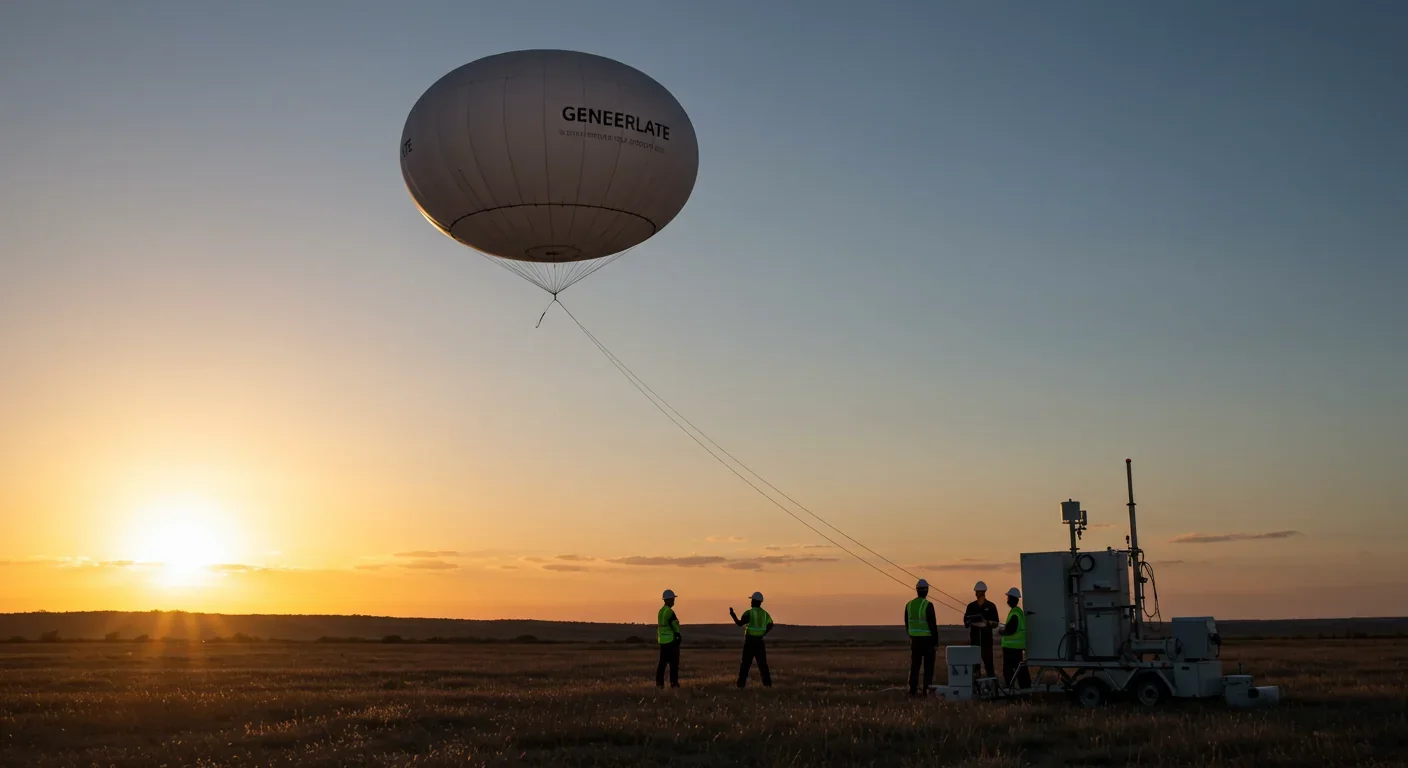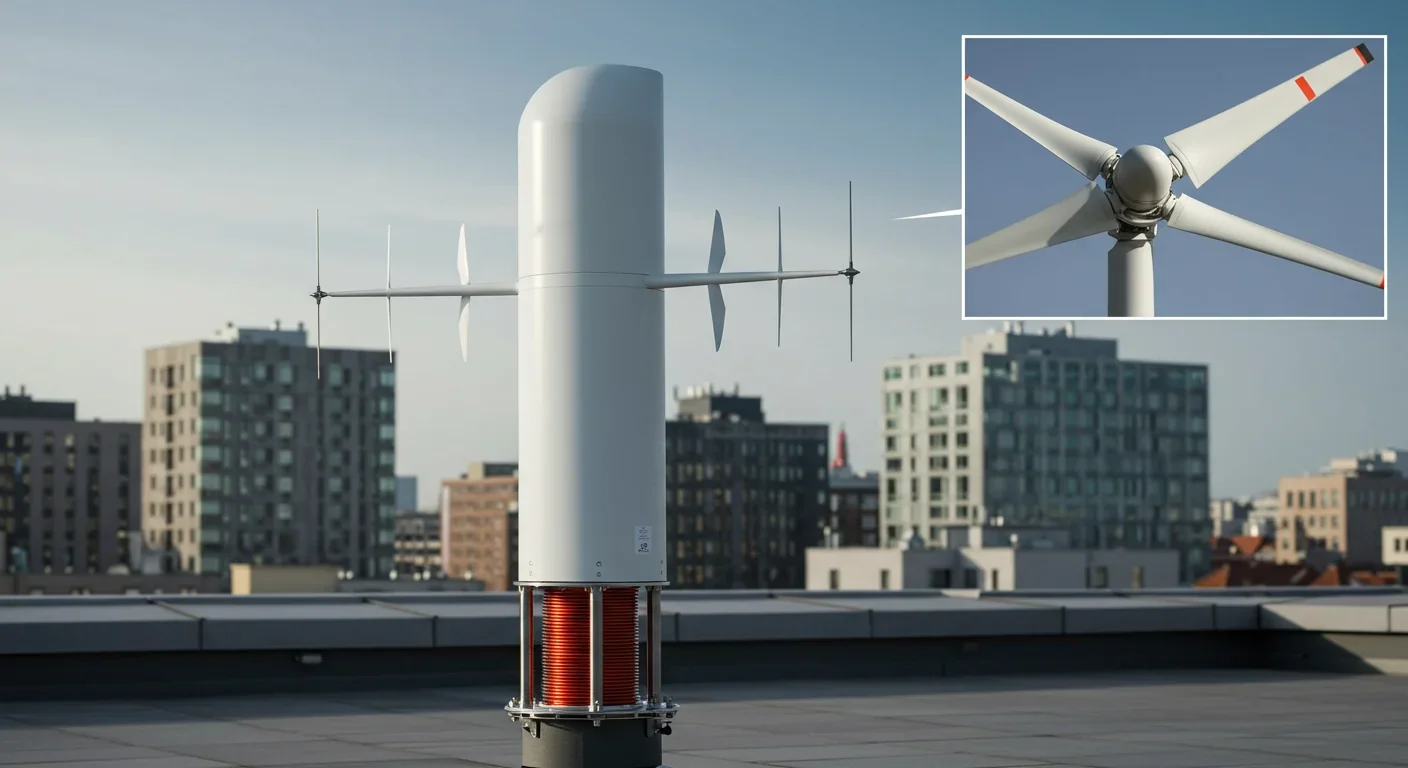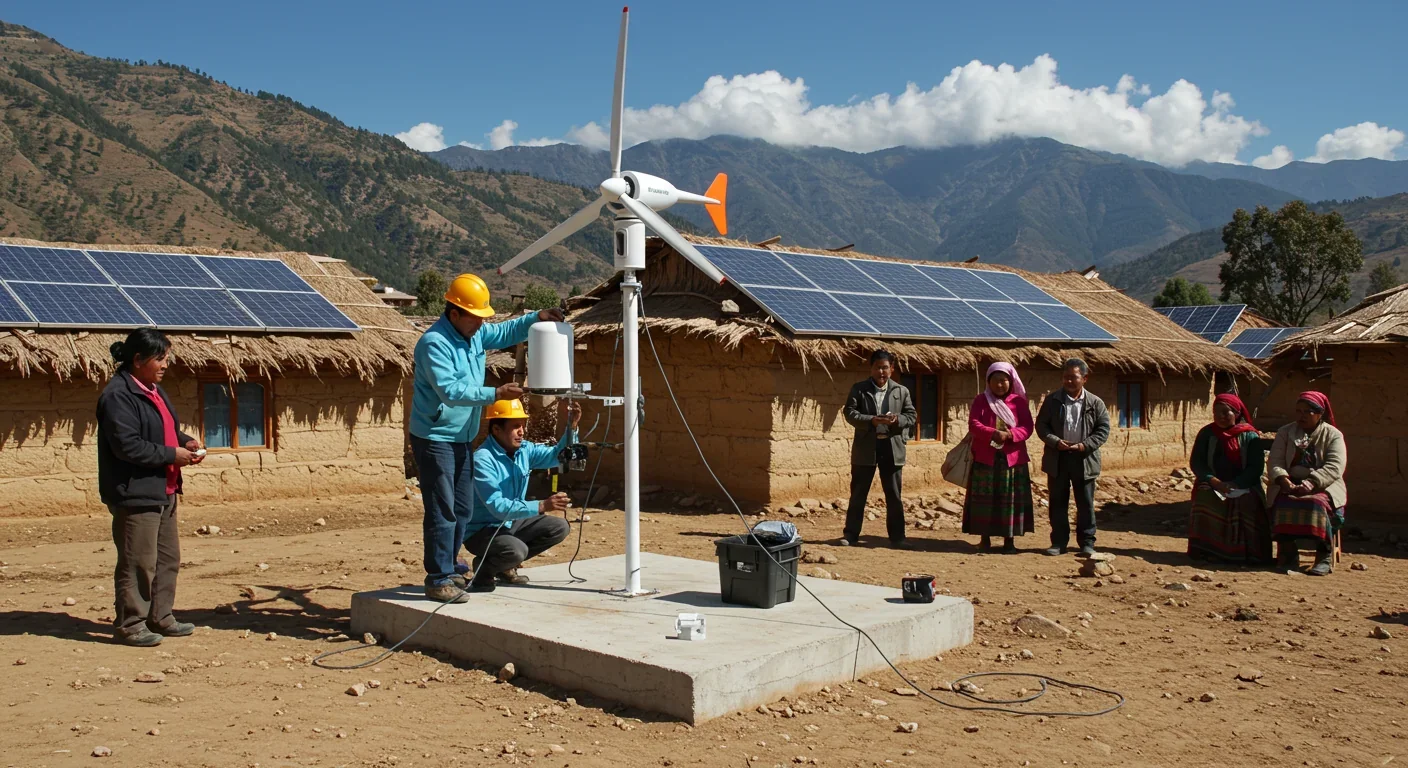Underground Air Storage: Renewable Energy's Hidden Battery

TL;DR: Bladeless turbines and airborne wind generators are revolutionizing clean energy by eliminating noise, wildlife deaths, and visual pollution while generating power at higher altitudes where winds are stronger and more consistent.

By 2030, the skyline of our cities and the horizons of our rural landscapes will look fundamentally different. Not because of more towering turbines slicing through clouds, but because wind energy is about to go invisible, silent, and airborne. The future of clean power isn't just cleaner—it's unrecognizable.
For over a century, we've imagined renewable energy through the lens of the possible. Massive blades spinning atop steel towers became the icon of sustainable power. But what if everything we thought we knew about harvesting wind was wrong? What if the most efficient turbines have no blades at all? What if the best place to catch the wind isn't on the ground, but floating hundreds of meters in the sky?
This isn't science fiction. It's happening right now, from test fields in Germany to experimental zones over China's skies. The wind power revolution you haven't heard about is already here.
The paradox sounds impossible: a wind turbine with no blades that generates electricity. Yet companies like Vortex Bladeless have turned this contradiction into commercial reality. Their cylindrical masts oscillate in the wind through a phenomenon called vortex shedding—the same aerodynamic principle that once caused bridges to collapse now powers homes.
Traditional turbines kill hundreds of thousands of birds annually and produce noise pollution that makes them unwelcome near residential areas. Bladeless designs eliminate both problems entirely. These innovative turbines operate silently, making them perfect for urban environments where conventional wind farms would never be permitted.
But the real game-changer isn't what happens on the ground. It's what's taking flight above it.
In September 2025, China successfully tested the world's largest airborne wind turbine, a megawatt-level flying generator tethered to the ground but harvesting energy at altitudes where wind speeds are twice as strong and four times more consistent than at ground level. Think of it as a kite that generates enough electricity to power a small town.
The physics are elegant. Wind speed increases exponentially with altitude. At 300 meters up, you're not just catching stronger breezes—you're tapping into jet stream energy that never stops. Airborne wind turbines harness this power through lightweight platforms that cost a fraction of traditional turbines to build and deploy.
Humans have always had a complicated relationship with wind. For millennia, we saw it as an enemy to shelter from, a chaotic force that destroyed crops and sank ships. The Dutch changed that narrative in the 1400s, using windmills to reclaim land from the sea. By the 1800s, American farmers dotted the Great Plains with wind pumps, making agriculture possible in arid regions.
But it was Denmark that transformed wind from farm tool to power source. In 1891, Poul la Cour built the first electricity-generating wind turbine, proving that atmospheric chaos could be converted into orderly electrons. For the next century, the design barely changed: bigger blades, taller towers, the same basic physics.
We learned important lessons from this history. The 1970s oil crisis sparked the first modern wind boom, but early turbines were unreliable, noisy, and inefficient. Companies went bankrupt. Governments abandoned subsidies. The technology almost died before it started. What saved it wasn't just better engineering—it was persistence and incremental innovation. Each failure taught engineers what didn't work, paving the way for today's 15-megawatt offshore behemoths.
Now we're at another inflection point. Just as the first computers filled entire rooms before shrinking to fit our pockets, wind power is about to become radically smaller, quieter, and more versatile. The lessons from past failures have prepared us for what comes next.
Bladeless turbines work through vortex-induced vibration. When wind flows past a cylindrical structure, it creates alternating low-pressure zones that cause the structure to oscillate. Vortex Bladeless captures this motion with elastic rods and converts the kinetic energy into electricity through alternators at the base.
The genius is in the tuning. Each turbine adjusts its rigidity to match wind speeds, ensuring it vibrates at the optimal frequency to maximize power generation. There are no gears to maintain, no lubricants to replace, no massive blades to stress test. Maintenance costs drop by 80% compared to conventional designs.
For urban applications, French startups are developing compact bladeless units that can sit on rooftops or in parks, generating 2,400 watts continuously without the visual impact or noise of traditional turbines. You could install one in your backyard and your neighbors wouldn't even notice.
Airborne systems take a different approach entirely. Kitepower's technology, recently authorized for operation in Germany, uses autonomous kites attached to ground-based generators. As the kite flies in figure-eight patterns, it pulls a tether that drives the generator. When the tether fully extends, the kite depowers and retracts with minimal resistance, then repeats the cycle.

Other designs keep the generator airborne. China's floating megawatt turbine uses helium-filled aerostats to stay aloft while onboard generators send power down through conductive tethers. It's like a power plant that flies.
The University of Glasgow recently announced improvements to airborne efficiency that pushed energy capture rates above 60%—better than most ground-based farms. They achieved this through AI-controlled flight patterns that keep the turbine in optimal wind conditions 24/7.
For the first time in history, we're looking at renewable energy that doesn't ask communities to choose between sustainability and quality of life. You don't have to accept noise pollution to be green. You don't have to sacrifice bird populations for clean power. You don't have to industrialize pristine landscapes to fight climate change.
This matters more than the technology itself. Wind power has faced fierce local opposition in communities worldwide because conventional turbines are, frankly, intrusive. They're loud, they're massive, and they change the character of rural areas. Bladeless designs eliminate these objections, making wind power politically feasible in places that would never accept traditional farms.
The decentralization potential is enormous. Today's energy grid is fundamentally colonial in structure: power generated in rural sacrifice zones gets transmitted to urban consumption centers. Communities host the infrastructure, cities reap the benefits. Bladeless and airborne technologies flip this model. Every building becomes a potential power plant. Every parking lot could host a small wind farm invisible from street level.
For remote communities and islands, airborne wind energy offers independence from diesel generators and undersea cables. A single tethered turbine can power a research station in Antarctica or a village in the Arctic, places where conventional turbines freeze solid and ground-based installation is prohibitively expensive.
Military applications are driving significant investment. Airborne turbines can deploy rapidly to provide power for forward operating bases without the logistical nightmare of fuel convoys. The U.S. Department of Defense has tested systems that fit in shipping containers and deploy in under an hour.
But the most profound impact might be psychological. When clean energy becomes invisible and silent, it stops being a political statement and becomes simply infrastructure. The culture war around renewable energy deflates when there's nothing to fight about.
The economic case is compelling. Bladeless turbines use 90% less material than blade-based designs and can be manufactured with standard industrial processes—no specialized composite materials or precision machining required. Production costs are projected to fall below $100 per installed kilowatt within five years.
Vortex's residential units already generate power for around $0.02 per kilowatt-hour over their 20-year lifetime, competitive with utility-scale solar. Unlike solar, they work at night and during cloudy weather, providing more consistent generation.
The maintenance revolution can't be overstated. Conventional turbines require specialized crews to rappel down blades or use helicopter platforms for inspections. Each turbine needs servicing every six months, with major overhauls every five years. Bladeless systems have virtually no moving parts. Airborne platforms can be reeled in for ground-level maintenance.
For developing nations, this accessibility is transformative. Countries that lack the industrial base to manufacture precision turbine components can still deploy bladeless and airborne systems. Turkey, for instance, is investing heavily in airborne wind energy as a way to leapfrog expensive conventional infrastructure.
The wildlife benefit deserves its own category. Bird and bat deaths from conventional turbines number in the millions annually, creating genuine environmental tension around wind power. Bladeless designs and high-altitude airborne systems operate in zones where bird strikes are virtually impossible. For conservationists who support renewable energy but mourn its avian casualties, these technologies resolve an impossible dilemma.
Speed of deployment matters too. A conventional wind farm takes two to three years from planning to operation. Airborne systems can be operational in weeks, crucial for disaster relief or rapid military deployment. When Hurricane Maria devastated Puerto Rico, the long rebuilding timeline for conventional power infrastructure left communities in the dark for months. Airborne wind energy could have restored power in days.
Let's be clear: these technologies face real obstacles. The regulatory framework for airborne wind energy barely exists. Who controls the airspace between 200 and 1,000 meters? What happens when a tether snaps and a multi-ton turbine falls from the sky? Insurance companies are still figuring out how to price these risks.
Kitepower's German authorization was a breakthrough precisely because it's so rare. Most countries have no legal pathway for permanent airborne structures. Aviation authorities worry about collision risks. Military officials fear interference with radar and communications.
The standardization problem is equally thorny. With dozens of competing designs—kites, blimps, drones, Magnus-effect rotors—there's no agreed-upon best approach. This fragmentation slows investment because utilities don't know which technology will win. It's the Betamax versus VHS problem all over again.

Weather presents challenges that sound ironic for wind technology. Thunderstorms force airborne systems to reel in and shut down. Ice accumulation at altitude can ground operations for days. While these systems capture more consistent wind than ground-based turbines, they're also exposed to more extreme conditions.
The intermittency issue hasn't disappeared. Even at high altitude, wind varies. Without massive battery storage or grid integration, airborne and bladeless systems face the same criticism as all renewable energy: they can't provide baseload power on demand. The duck curve problem—when solar ramps down at sunset just as demand increases—has an airborne equivalent during seasonal calm periods.
Energy density remains a limitation. A single conventional offshore turbine can generate 15 megawatts. The largest airborne systems currently max out at 1-2 megawatts. To replace fossil fuel capacity, we'd need thousands of airborne units where hundreds of conventional turbines would suffice. More units mean more points of failure, more maintenance, more complexity.
There's also the problem of what happens when these technologies succeed too well. If every building hosts a bladeless turbine and urban airspace fills with tethered generators, we create new forms of visual pollution and navigational hazards. The solution to one problem becomes the next problem.
China is approaching airborne wind energy with characteristic ambition. Their megawatt-level test flight in September 2025 wasn't just a technology demonstration—it was a statement of intent. Chinese officials see airborne wind as a way to power remote western provinces without building thousands of miles of transmission lines. They're investing billions in developing airborne fleets that could fly in coordinated patterns, creating virtual power plants in the sky.
Europe, particularly Germany and France, is taking a more regulatory-first approach. The European Union is crafting airspace management frameworks before large-scale deployment. This cautious path might slow initial rollout but could prevent the safety incidents that would doom the industry. German engineering culture prizes reliability over speed, and that mindset shapes their airborne wind strategy.
France's market focus emphasizes integration with existing infrastructure. French utilities want airborne systems that complement nuclear baseload power by filling gaps during peak demand. This pragmatic view sees new wind technology not as a revolutionary replacement but as another tool in a diversified energy toolkit.
Developing nations are watching these experiments closely. For island nations like the Philippines or Indonesia, airborne wind could eliminate dependence on imported diesel. For landlocked countries with limited ground-based wind resources, high-altitude systems unlock potential that didn't previously exist. The market analyses predict explosive growth in Asia and Latin America if costs continue falling.
Cultural attitudes toward technology adoption vary dramatically. Northern European countries embrace airborne wind as innovation and progress. In the Middle East, there's skepticism about technologies that haven't proven themselves at scale. In Japan, where space is precious and typhoons are regular, compact bladeless designs attract more interest than airborne systems vulnerable to extreme weather.
The collaboration versus competition dynamic is fascinating. Unlike solar panels or batteries, where intellectual property is fiercely guarded, airborne wind developers share safety data and regulatory strategies. They recognize that a catastrophic failure anywhere would hurt the entire industry. This unusual cooperation between competitors might accelerate development faster than traditional market competition.
The skills needed for this energy transition are already available—you just have to know where to look. Aerospace engineers who designed drones will design flying turbines. Material scientists working on lighter composites for aircraft will develop the next generation of tethers. Software developers building autonomous vehicle systems will write the algorithms that keep airborne turbines optimally positioned.
For workers in conventional wind energy, the transition won't be as disruptive as you might think. Installation skills transfer directly—you're still anchoring systems and connecting them to grids. Maintenance becomes easier, not harder. If you can troubleshoot electrical systems and mechanical components, you can work on bladeless or airborne technology.
Investors should watch the regulatory environment as closely as the technology. The first countries to create clear legal frameworks for airborne wind will attract the industry's manufacturing and testing facilities. This is a rare opportunity to influence where the next clean energy boom happens through policy rather than just subsidies.
Communities considering wind energy should demand trials of multiple technologies. Don't accept that conventional turbines are the only option. Ask why bladeless systems wouldn't work. Demand impact studies on airborne alternatives. The technology exists—deployment is now a matter of awareness and political will.
For the environmentally conscious individual, the message is both hopeful and urgent. We're about to solve major objections to renewable energy, but only if we push for deployment. Contact local representatives. Attend planning meetings. When utilities propose new power plants, ask why they're not considering bladeless or airborne alternatives.
Students choosing careers should know this: the airborne wind industry will need tens of thousands of engineers, technicians, and specialists over the next decade. Universities are already building programs around this technology. The expertise you build now will be rare and valuable.
Standing at this moment feels like being in 1995, watching the internet transition from academic curiosity to world-changing infrastructure. We can see where this is going, but we can't yet imagine all the implications.
The child born today will grow up in a world where power generation is invisible and ubiquitous. They won't think wind turbines need blades any more than they'll think phones need cords. Energy will come from the sky not metaphorically but literally, from devices so quiet and unobtrusive they fade into the background of daily life.
This isn't just about climate change, though that alone would justify the revolution. It's about democratizing power generation, eliminating the environmental compromises that made clean energy politically contentious, and proving that technological progress doesn't require sacrifice—it requires imagination.
The wind has been blowing for billions of years. We've been trying to harness it for centuries. We're finally learning to do it right. The turbines of tomorrow won't dominate landscapes—they'll disappear into them. And in that invisibility, we might find not just clean energy, but something more valuable: proof that human innovation and environmental harmony aren't opposites. They're partners.
The future of wind power isn't written yet. But it's being tested right now, in the skies over China and the fields of Germany, in laboratories and on rooftops, by engineers who believe the best way to catch the wind is to think completely differently about what a turbine can be.
That future is flying toward us. The question isn't whether it will arrive. It's whether we'll be ready when it does.

MOND proposes gravity changes at low accelerations, explaining galaxy rotation without dark matter. While it predicts thousands of galaxies correctly, it struggles with clusters and cosmology, keeping the dark matter debate alive.

Ultrafine pollution particles smaller than 100 nanometers can bypass the blood-brain barrier through the olfactory nerve and bloodstream, depositing in brain tissue where they trigger neuroinflammation linked to dementia and neurological disorders, yet remain completely unregulated by current air quality standards.

CAES stores excess renewable energy by compressing air in underground caverns, then releases it through turbines during peak demand. New advanced adiabatic systems achieve 70%+ efficiency, making this decades-old technology suddenly competitive for long-duration grid storage.

Our brains are hardwired to see patterns in randomness, causing the gambler's fallacy—the mistaken belief that past random events influence future probabilities. This cognitive bias costs people millions in casinos, investments, and daily decisions.

Forests operate as synchronized living systems with molecular clocks that coordinate metabolism from individual cells to entire ecosystems, creating rhythmic patterns that affect global carbon cycles and climate feedback loops.

Generation Z is the first cohort to come of age amid a polycrisis - interconnected global failures spanning climate, economy, democracy, and health. This cascading reality is fundamentally reshaping how young people think, plan their lives, and organize for change.

Zero-trust security eliminates implicit network trust by requiring continuous verification of every access request. Organizations are rapidly adopting this architecture to address cloud computing, remote work, and sophisticated threats that rendered perimeter defenses obsolete.